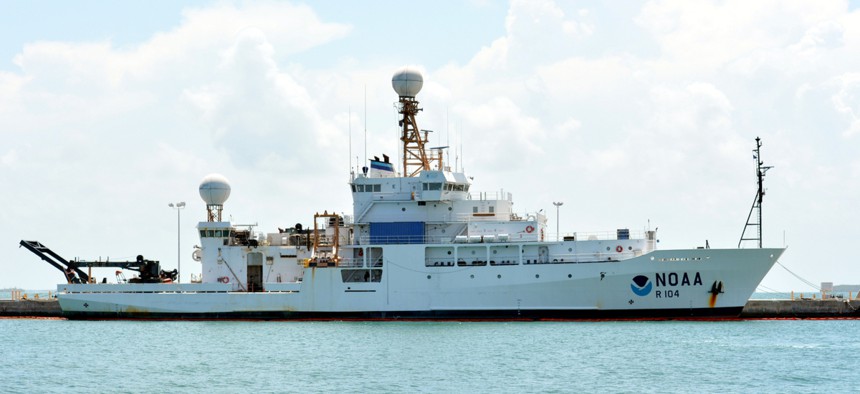NOAA to Solicit Public Insight on Four Draft Science and Technology Strategies

A NOAA research vessel. Chuck Wagner/Shutterstock.com
Focus areas include artificial intelligence, unmanned systems, ‘omics, and the cloud.
The National Oceanic and Atmospheric Administration wants the public to weigh in on four technology-focused strategies it’s produced to steer future artificial intelligence, unmanned systems, ‘omics, and cloud efforts.
“These strategies are intended to dramatically expand our application of these four emerging science and technology focus areas by improving the efficiency, effectiveness and coordination of their development and usage across the agency,” officials wrote in a notice of public comment set to be published in the Federal Register Thursday.
NOAA has worked to advance solutions across all four areas in recent years and guidance from both Congress and President Trump’s administration also influenced the draft strategies’ development. The executive order on Maintaining American Leadership in Artificial Intelligence, Federal Cloud Computing Strategy, a research and development priorities letter from the Office of Science and Technology Policy, and the Weather Research and Forecasting Innovation Act, among others, were listed as avenues of inspiration. And once comments are collected and the strategies are completed, the agency aims to create strategic implementation plans that will detail the action items and relevant deadlines going forward.
“In the meantime, these NOAA S&T focus areas are already improving performance in our economically impactful missions and setting the course to strengthen our renowned environmental science and technology leadership for the coming decades,” the agency said.
NOAA’s AI strategy ultimately aims to expand its applications of the budding technology, reduce data-processing costs, and enhance the products and services it offers to benefit the public. The agency already implements many AI efforts to boost its mission, including to improve the accuracy of the National Weather Service’s weather modeling, better detect rip currents from coastal imagery, and it is also harnessing machine learning to provide better science for policy decisions on protected and endangered species. Specific AI goals listed in the strategy include promoting its workforce’s understanding and proficiency of the technology, expanding multi-stakeholder partnerships, establishing a stronger organizational structure to advance its AI efforts and accelerate the transition from research to operational capabilities.
The agency uses unmanned aircraft and marine systems to meet a variety of mission goals. For example, NOAA’s Office of Coast Survey launched an autonomous vehicle on a recent underwater mapping mission and researchers have also deployed a hexacopter to monitor depleting species populations. Through its unmanned systems strategy, the agency seeks to accelerate its systems’ capabilities, increase and strengthen partnerships, and better coordinate unmanned systems operations at the enterprise level.
NOAA is already leveraging cloud applications to advance big data analysis and storage, numerical weather prediction, ocean models and satellite services. Going forward, insiders plan to “migrate suitable IT services to commercial cloud computing environments to reduce costs, improve efficiency, provide unlimited seamless scalability, and maintain high levels of security.” The agency’s cloud strategy goals include rapidly adopting more cloud-based services, offering governance for shared services, and empower a “cloud-ready workforce,” among others.
And according to NOAA, ‘omics tools are used to analyze materials like DNA, RNA and proteins and specific fields include genomics, transcriptomics, proteomics, and metabolomics. Through this strategy, the agency aims to leverage related technologies across the agency and ultimately enhance operational efficiency, stewardship and ecosystem assessments and forecasts.
“The draft strategies will ensure robust agency-wide coordination and strong institutional support from NOAA senior leadership for these emerging science and technology focus areas to guide transformational advances in the quality and efficiency of NOAA’s science, products, and services,” officials wrote.
The agency is accepting comments via email and snail mail for 30 days following the notice’s publication.






